Data structures and algorithms are the foundation of computer science and programming. They are essential tools enabling developers to create efficient, reliable, scalable software solutions. Data structures are used to organize and store data, while algorithms are used to manipulate that data to produce desired results. This article will explore the basics of data structures and algorithms and how they are used in software development.
Topics Covered:
1. What are Data Structures?
2. What is an Algorithm?
3. Why are Data Structures and Algorithms Important?
4. Types of Data Structures
5. How to Learn Data Structures and Algorithms?
6. Applications of Data Structures and Algorithms
7. Data Structures in JavaScript
8. Other Topics?
What are Data Structures?
Data structures are containers that hold and organize data in a specific way, making it easier to access, manipulate, and store. Various types of data structures include arrays, linked lists, stacks, queues, trees, and graphs.
Arrays are one of the simplest and most commonly used data structures. They are a collection of elements of the same type stored in contiguous memory locations. Arrays provide fast access to elements, but their size is fixed, which can limit their flexibility.
Linked lists can grow or shrink dynamically, making them suitable for use in situations where the size of data is not known in advance. Linked lists, however, are more flexible than arrays as they can dynamically allocate memory. They consist of nodes that store data and pointers that point to the next node in the list.
Stacks and queues are data structures that store and manipulate elements in a specific order. Stacks follow a last-in-first-out (LIFO) order, where the last element added to the stack is the first to remove. Queues follow a first-in-first-out (FIFO) order, where the first element added to the queue is the first one to be removed.
Trees and graphs are hierarchical data structures that organize and store data in a tree-like structure. Trees consist of nodes connected by edges, with a root node at the top and leaf nodes at the bottom. Conversely, graphs can have any number of nodes and edges that can be directed or undirected.
What is an Algorithm?
Algorithms are instructions or procedures used to manipulate data stored in data structures to produce desired results. Algorithms are designed to solve problems and can be executed in a particular sequence or order. There are various algorithms, including searching, sorting, and graph algorithms.
Searching algorithms find an element or a group of elements in a data structure. Some examples of searching algorithms are linear search, binary search, and depth-first search.
Sorting algorithms arrange elements in a specific order, such as ascending or descending. Some examples of sorting algorithms are bubble sort, insertion sort, and quicksort.
Graph algorithms are used to traverse and manipulate graphs. Some examples of graph algorithms are Dijkstra's Algorithm, Kruskal's Algorithm, and breadth-first search.
Every Algorithm must have the following characteristics:
1. Input- The Algorithm should receive 0 or more inputs from outside sources.
2. Output- At least one output should be obtained.
3. Definiteness- Each Algorithm step should be well-defined and unambiguous.
4. Finite- The Algorithm should have a finite number of steps.
5. Correctness- Each Algorithm step must produce a valid result.
If an algorithm takes less time to execute and consumes less memory space, it is considered efficient and fast. The following properties are used to assess an algorithm's performance:
1. Time Complexity
2. Space Complexity
Why are Data Structures and Algorithms Important?
Data structures and algorithms are essential components of software development. They help developers create efficient, scalable, and reliable software solutions. Using the proper data structure and algorithm can make a significant difference in the performance of an application.
For example, using a linked list instead of an array can improve an application's performance when inserting or deleting elements in the middle of the data structure. Similarly, an efficient sorting algorithm for large datasets can improve the application's overall performance.
Data structures and algorithms are crucial components of software development. They enable developers to create efficient, scalable, and reliable software solutions. As a developer, it is essential to have a solid understanding of data structures and algorithms to build high-quality software solutions. Choosing the proper data structure and Algorithm can have a significant impact on the performance of an application.
Types of Data Structures
As previously stated, anything that can store data is referred to as a data structure; thus, they are classified into two major categories:
1. Primitive Data Structures
2. Non-Primitive Data Structures
These are stated below:
1. Primitive Data Structures
Integers, floats, Booleans, Chars, and so on are all data structures. Therefore, they are referred to as Primitive Data Structures.
1. Integers
2. Floats
3. Booleans
4. Chars, etc
2. Non-Primitive Data Structures
The List of Non-Primitive Data Structures is stated below:
1. Linked List
2. Tree
3. Graph
4. Stack
5. Queue
Non-Primitive Data Structures
1. Arrays
In C++, an array is a data structure that allows you to store a fixed-size sequence of elements of the same data type. It provides a way to group related values under a single variable name for easy access and manipulation. Arrays are typically used when you need to store multiple elements of the same type, such as a list of integers, characters, or any other data type.
The elements in an array are accessed using an index, which is an integer value that represents the position of the element within the array. The first element is at index 0, the second element is at index 1, and so on. You can access, modify, and perform various operations on array elements using their respective indices.
Here's a simple example of an integer array declaration, initialization, and access:
#include <iostream>
int main() {
// Declare an array of integers with a size of 5
int myArray[5];
// Initialize the array with values
myArray[0] = 10;
myArray[1] = 20;
myArray[2] = 30;
myArray[3] = 40;
myArray[4] = 50;
// Access and print the elements of the array
std::cout << "Element at index 0: " << myArray[0] << std::endl;
std::cout << "Element at index 3: " << myArray[3] << std::endl;
return 0;
}
Arrays are powerful and widely used data structures, but they have a fixed size, meaning once you define an array with a specific size, you cannot change it during runtime. Also, using arrays directly in C++ requires careful management to avoid going out of bounds, which can lead to undefined behavior and potential crashes. Modern C++ provides alternatives like std::vector and std::array that offer more safety and flexibility for dynamic-sized arrays and additional functionality.
2. Linked List:
A linked list is a linear data structure in which elements, called nodes, are stored in a sequence where each node points to the next node in the list. Unlike arrays, where elements are stored in contiguous memory locations, linked lists allow for dynamic allocation of memory and efficient insertion or deletion of elements at any position. Here's a detailed explanation of linked lists in C++, along with a simple program to demonstrate its implementation:
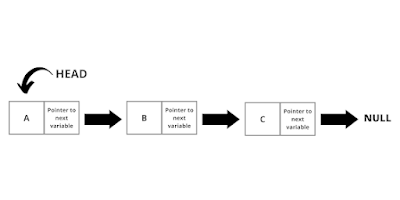 |
| Linked List |
#include <iostream>
// Define the structure for a node
struct Node {
int data; // Data stored in the node
Node* next; // Pointer to the next node
};
// Class to manage the linked list operations
class LinkedList {
private:
Node* head; // Pointer to the first node (head) of the list
public:
LinkedList() {
head = nullptr; // Initialize an empty linked list
}
// Function to insert a new node at the beginning of the list
void insertAtBeginning(int value) {
Node* newNode = new Node;
newNode->data = value;
newNode->next = head;
head = newNode;
}
// Function to display the linked list
void display() {
Node* current = head;
while (current != nullptr) {
std::cout << current->data << " ";
current = current->next;
}
std::cout << std::endl;
}
// Function to delete the entire linked list to free memory
void deleteList() {
Node* current = head;
while (current != nullptr) {
Node* nextNode = current->next;
delete current;
current = nextNode;
}
head = nullptr;
}
~LinkedList() {
deleteList(); // Destructor to automatically delete the list when object is destroyed
}
};
int main() {
LinkedList list;
// Insert elements at the beginning of the list
list.insertAtBeginning(3);
list.insertAtBeginning(7);
list.insertAtBeginning(1);
// Display the linked list
std::cout << "Linked List: ";
list.display();
// Clean up memory by deleting the list
list.deleteList();
return 0;
}
In this program, we've defined a simple linked list class named LinkedList. It has member functions to insert nodes at the beginning, display the list, and delete the list to free up memory. The Node structure represents the individual nodes of the linked list, containing the data and a pointer to the next node.
The main function demonstrates how to create a linked list, insert elements, display the list, and clean up memory by deleting the list.
Keep in mind that this is a basic implementation of a linked list. More advanced variations, such as singly linked lists, doubly linked lists, and circular linked lists, can be implemented with additional features and functionalities.
3. Tree :
A data structure is a specialized method of organizing and storing data in a computer to be used more effectively. Stacks, linked lists, and queues are data structures that can be arranged in sequential order. For example, a linked list data structure comprises nodes connected by links or points.
Similarly, the tree data structure is a type of hierarchical data organized as a tree. It is made up of a central node, structural nodes, and sub-nodes that are linked together by edges. A tree data structure comprises roots, branches, and leaves that are all connected.
A tree is a nonlinear and hierarchical data structure consisting of nodes that store a value and a list of references to other nodes (the "children").
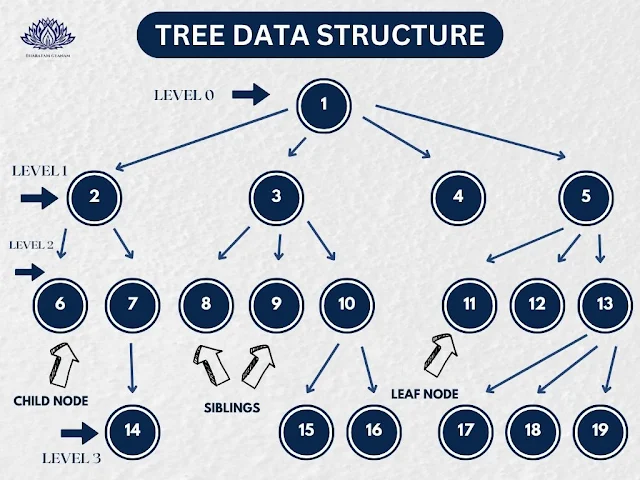 |
| Tree Data Structure |
4. Graph:
A graph is a nonlinear data structure made up of nodes and edges. The nodes are also known as vertices; edges are lines or arcs connecting any two nodes in the graph. There are various types of graphs in data structures. A Graph can be defined more formally as,
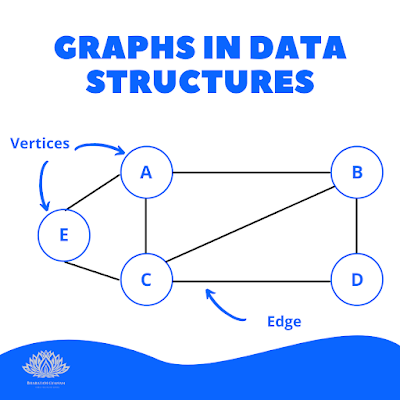 |
Graphs Data Structures
|
5. Stacks:
A stack data structure is an Abstract Data Type (ADT) found in almost all programming languages. It is called a stack because it behaves like a real-world stack, such as a deck of cards or a pile of plates.
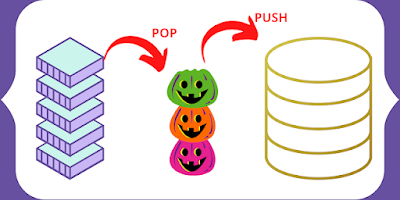 |
Stacks Data Structures
|
6. Queue:
A queue is a linear structure in which operations are performed in a specific order, First In, First Out order (FIFO). For example, any queue of consumers for a resource in which the consumer who arrived first is served first is an example of a queue. The distinction between stacks and queues is in the removal process. In a stack, we remove the most recently added item, but in a queue, we remove the least recently added item.
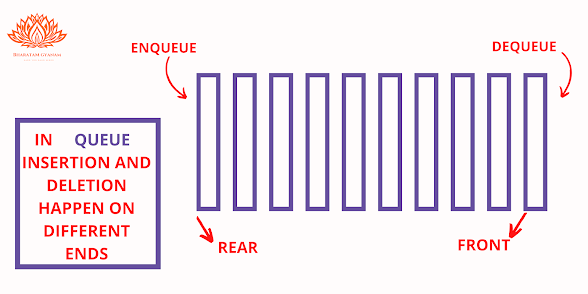 |
| Queue Data Structures |
How to Learn Data Structures and Algorithms?
Learning data structures and algorithms is essential for any software developer or computer science student. Here are some tips on how to learn data structures and algorithms effectively:
1. Start with the basics: It's essential to have a strong foundation in programming before diving into data structures and algorithms. Make sure you have a good understanding of programming concepts such as variables, loops, functions, and conditional statements.
2. Choose a programming language: There are many programming languages to choose from when implementing data structures and algorithms. Choose a language that you're comfortable with, and that has good support for data structures and algorithms. Some popular programming languages for implementing data structures and algorithms are Java, Python, and C++.
3. Learn the fundamentals: Learn basic data structures such as arrays, linked lists, stacks, and queues. Learn how to implement them in code and their time and space complexities.
4. Practice, practice, practice: The best way to learn data structures and algorithms is to practice implementing them. Solve programming problems that involve data structures and algorithms. There are many resources online that provide practice problems and challenges.
5. Learn advanced data structures and algorithms: Once you've mastered the basics, move to more advanced data structures such as trees, graphs, and hash tables. Learn how to implement more complex algorithms such as sorting, searching, and graph algorithms.
6. Read books and watch tutorials: Many books and online tutorials cover data structures and algorithms. Find a resource that suits your learning style and work through the examples and exercises.
7. Collaborate with others: Collaborate with other developers or students to solve programming problems that involve data structures and algorithms. Working with others can help you learn new approaches and techniques.
Applications of Data Structures and Algorithms
Data structures and algorithms have a wide range of applications in software development. Some typical applications include:
1. Database Management: Data structures such as trees and hash tables are used in database management systems to organize and index data for efficient storage and retrieval.
2. Operating Systems: Operating systems use data structures such as queues and stacks to manage processes and resources.
3. Artificial Intelligence: Data structures such as graphs are used in artificial intelligence applications such as pathfinding, clustering, and recommendation systems.
4. Web Development: Data structures such as arrays and linked lists are used in web development to manage data and store information about web pages and their contents.
5. Games: Data structures and algorithms are used extensively in game development for pathfinding, collision detection, and artificial intelligence tasks.
6. Networking: Data structures such as trees and graphs are used in networking applications to represent network topologies and routing algorithms.
7. Machine Learning: Data structures such as arrays and matrices are used in machine learning applications for storing and manipulating data.
Data Structures in JavaScript
JavaScript provides several built-in data structures that allow you to store and manipulate data efficiently. Here are some commonly used data structures in JavaScript, along with explanations and simple code examples:
Arrays:
Arrays are one of the simplest and most widely used data structures in JavaScript. They store elements in a sequential order, and each element can be accessed using its index. Arrays are versatile and can hold different data types, including numbers, strings, objects, or even other arrays.
1. An array is a collection of values stored in a single variable.
2. Elements in an array can be of different data types.
3. Arrays are ordered, and elements can be accessed by their index (0-based).
Objects:
1. Objects are collections of key-value pairs.
2. Keys (also known as properties) are strings, and values can be of any data type.
3. Objects are unordered, and you can access values by their keys.
Linked List in JavaScript
// Node class for a linked list
class Node {
constructor(data, next = null) {
this.data = data;
this.next = next;
}
}
// Creating a linked list
let node1 = new Node(10);
let node2 = new Node(20);
let node3 = new Node(30);
node1.next = node2;
node2.next = node3;
console.log(node1);
console.log(node2);
console.log(node3);
Output:
Node {
data: 10,
next: Node { data: 20, next: Node { data: 30, next: null } }
}
Node { data: 20, next: Node { data: 30, next: null } }
Node { data: 30, next: null }
Stacks and Queues
Stacks and queues are data structures that manage elements based on the order of insertion and removal. In a stack, the last element added is the first one to be removed (Last In, First Out - LIFO). Conversely, in a queue, the first element added is the first one to be removed (First In, First Out - FIFO).
Stack Implementation in JavaScript
class Stack {
constructor() {
this.items = [];
}
// Add element to the stack
push(element) {
this.items.push(element);
}
// Remove and return the top element from the stack
pop() {
if (this.isEmpty()) {
return "Underflow";
}
return this.items.pop();
}
// Return the top element without removing it
peek() {
return this.items[this.items.length - 1];
}
// Check if the stack is empty
isEmpty() {
return this.items.length === 0;
}
// Return the size of the stack
size() {
return this.items.length;
}
// Print the stack elements
print() {
console.log(this.items.join(' '));
}
}
// Example usage:
const stack = new Stack();
stack.push(10);
stack.push(20);
stack.push(30);
console.log("Top element is", stack.peek()); // Output: 30
console.log("Stack size is", stack.size()); // Output: 3
stack.pop();
console.log("Popped element"); // Output: Popped element
stack.print(); // Output: 10 20
Queue Implementation in JavaScript
class Queue {
constructor() {
this.items = [];
}
// Add element to the queue
enqueue(element) {
this.items.push(element);
}
// Remove and return the front element from the queue
dequeue() {
if (this.isEmpty()) {
return "Underflow";
}
return this.items.shift();
}
// Return the front element without removing it
front() {
if (this.isEmpty()) {
return "No elements in Queue";
}
return this.items[0];
}
// Check if the queue is empty
isEmpty() {
return this.items.length === 0;
}
// Return the size of the queue
size() {
return this.items.length;
}
// Print the queue elements
print() {
console.log(this.items.join(' '));
}
}
// Example usage:
const queue = new Queue();
queue.enqueue(10);
queue.enqueue(20);
queue.enqueue(30);
console.log("Front element is", queue.front()); // Output: 10
console.log("Queue size is", queue.size()); // Output: 3
queue.dequeue();
console.log("Dequeued element"); // Output: Dequeued element
queue.print(); // Output: 20 30
Maps and Sets
ES6 introduced Map and Set data structures. Maps allow you to store key-value pairs, similar to objects, but with some differences. Sets, on the other hand, store unique values, ensuring that each element is unique within the set.
// Map example
let myMap = new Map();
myMap.set('name', 'Alice');
myMap.set('age', 30);
console.log(myMap.get('name')); // Output: Alice
// Set example
let mySet = new Set();
mySet.add(10);
mySet.add(20);
mySet.add(10); // Ignored, as 10 is already in the set
Other Topics






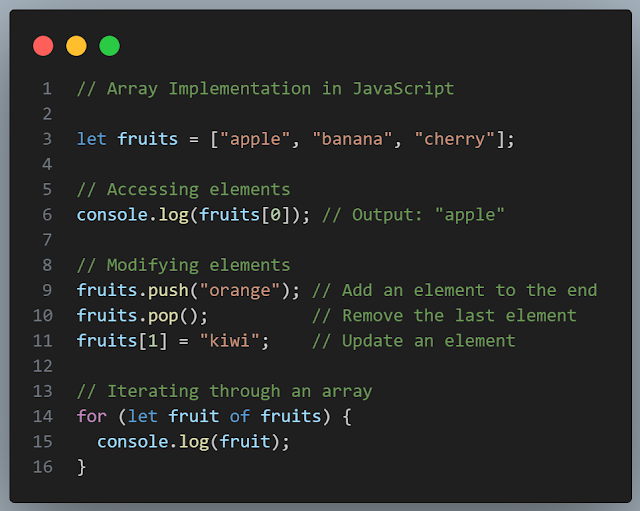

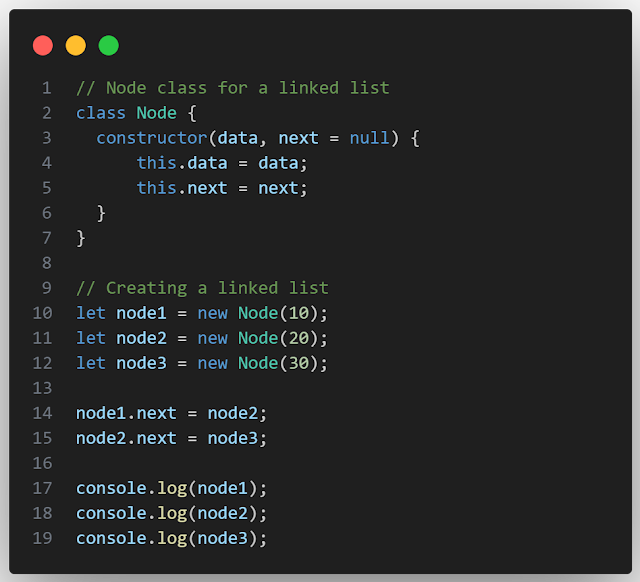
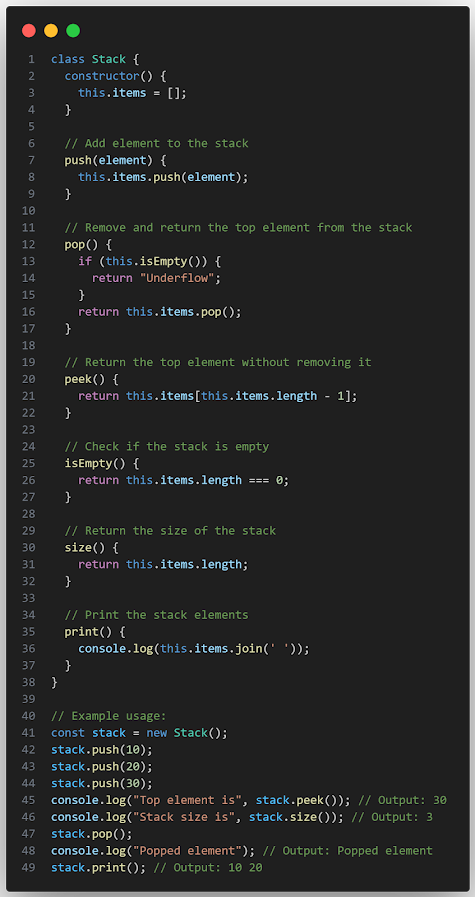
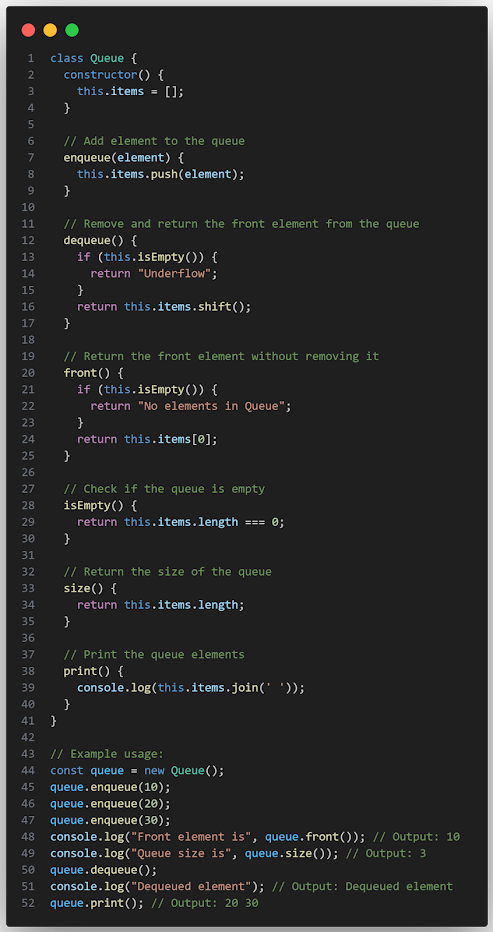
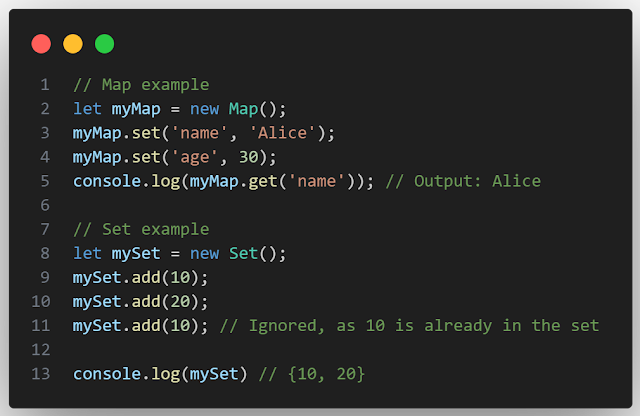





0 Comments